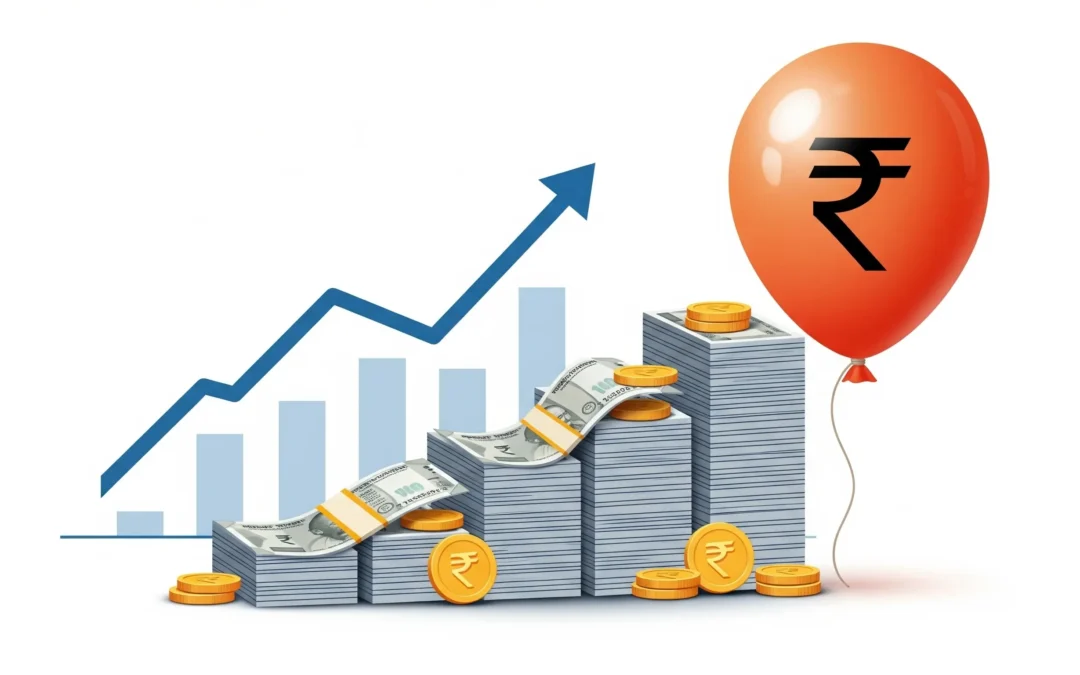Inflation is also very popularly known by everyone as a “silent thief” of money. It reduces the value of every rupee you possess, although it doesn’t really withdraw money from your bank account. Even a minimal amount of inflation over the long run will reduce the value of your savings, especially when people are not investing them correctly.
This article examines how inflation affects savings in the real world.
What is Inflation?
The overall increase in the price of goods and services during a particular span of time is called inflation. The price of essential items such as food, fuel, transport, medicines, and education rises with inflation. That is, if inflation keeps going on, ₹100 now will not be the same as in the following year, so a rupee will have decreased in value.
Inflation is often measured using the Consumer Price Index (CPI), which tracks the average change in prices of a basket of essential goods and services over time.
Let us help you understand the types of inflation:
| Inflation Type | Meaning |
| Demand-Pull Inflation | Occurs when demand(D) exceeds supply(S) from consumers, therefore raising prices. (D>S) |
| Cost-Push Inflation | Results occur when manufacturers transfer increased costs of production to consumers. |
| Built-in Inflation | A built-in inflationary cycle is brought about by increasing wages and the anticipation that prices will continue to rise. |
How Savings Lose Value Due to Inflation?
When you compare the nominal value of your savings with their value after inflation over a period of time, the impact of inflation will be most evident. People are actually losing their money if the interest rate on their funds is lower than the inflation rate.
For example, assume that you invest ₹1,00,000 in a savings account that gives a 3% per annum interest rate, and you have an inflation rate of 6%. Let’s see how it varies over the next five years:
The formula for calculating Nominal Savings and Inflation Adjusted value is:
Nominal Savings = Principal x (1+ Interest Rate/100)^year
- For year 1,
Nominal Savings = ₹1,00,000 x (1+ 3/100)^1 = ₹1,03,000
Inflation-Adjusted Value = Nominal savings/(1+ Inflation Rate/100)^year - For the same 1 year,
Inflation-Adjusted Value = ₹1,03,000/(1+ 6/100)^1 = ₹97,170.
Based on these formulas, the remaining values for subsequent years are calculated and shown in the table.
| Year | Nominal Savings (3% Interest) | Inflation-Adjusted Value (6%) |
| 1 | ₹1,03,000 | ₹97,170 |
| 2 | ₹1,06,090 | ₹94,160 |
| 3 | ₹1,09,273 | ₹91,170 |
| 4 | ₹1,12,551 | ₹88,200 |
| 5 | ₹1,15,927 | ₹85,250 |
Return on Investments and Inflation
The actual return on your investment is largely influenced by inflation. Although everyone is concerned about nominal return, or the nominal rate of gain, they typically do not notice the part of that return taken up by inflation.
Fixed bonds, fixed deposits, and savings accounts are some of the fixed-income investments that are most sensitive to inflation. Although these instruments can provide safety, they usually do not keep up with the rising cost of living.
Conversely, long-term investment in securities such as stocks or mutual funds generally has better immunity to inflation. This is because firms will raise prices and sales in the event of inflation, resulting in higher profits to investors. One should thus select instruments that exceed inflation to create and maintain wealth.
General economic conditions, such as interest rates and consumer spending, which are also impacted by an inflationary environment, impact investment returns. This requires an active investment policy that reacts to changing inflation dynamics. You can better safeguard your financial goals by periodically reviewing and rebalancing your portfolio with inflation in mind.
The table below shows the differences in investment options based on their average annual returns and whether they beat inflation.
| Investment Option | Average Return (Annual) | Inflation Beater? |
| Savings Account | 2.5%–3.5% | No |
| Fixed Deposits | 5%–6.5% | Barely |
| Equity Mutual Funds | 10%–12% | Yes |
| Public Provident Fund | 7%–8% | Yes |
| Stock Market (Direct) | 12%+ (long-term average) | Yes |
Bottomline
Even though you cannot see inflation, it has real impacts. It can actually reduce the purchasing power of your savings significantly, disrupt your financial objectives, and make it harder to achieve your life goals if you take no action. Successful long-term wealth creation demands active management of your funds in order to be able to neutralize inflation and know how it acts. You must invest your money wisely in such investments that provide actual growth after inflation, rather than merely saving it.
You may save your savings and attain a secure financial future by the proper combination of investment, planning, and awareness.
Written by: Tanya Kumari


